Photographer’s Guide to White Sands National Park
8 Comments
As a thanks for your readership, here are the entire notes from the White Sands National Park section of the upcoming Treasured Lands reprint. I would appreciate it if you vote in the one-question poll for your favorite spread, and also report any errors.
Like Bryce Canyon National Park, White Sands National Park is moderately sized and centered around a single geological feature that is unique and visually stunning. Remarkable plants add to the interest. The white sand dunes draw photographers from around the world because they are so photogenic. They are a great place to exercise one’s creativity because there are so many elements to photograph but no iconic locations. I enjoy the possibilities to explore freely without the impacts caused by off-trail hiking, easily escape the crowds, and find solitude.
Orientation
Dune Drive leads from the visitor center to the heart of the dunes in 8 miles along which vegetation density decreases and dune size increases. The first 5 miles are paved and the last 3 miles are hard-packed sand, suitable for any vehicle. Out of the 5 official trails in the park, one is a boardwalk, and three are hiking routes in the dunes marked by metal posts at distant intervals. After parking at one of the designated pull outs or lots, you can wander anywhere on the dunes. Walking 15 to 30 minutes from the road and away from the trails is enough to find dunes devoid of footprints. As it is easy to become disoriented in the dune field, orient yourself to the surrounding mountains. GPS is very useful, but due to interference caused by the military, it can be unreliable. The White Sands Missile Range, site of the first nuclear explosion, surrounds the park, which occasionally closes for a few hours during missile testing. Half of the park is a cooperative use zone shared with the military. The park opens at 7 am and closes about an hour after sunset. To photograph at night or at sunrise, there are two options. You can obtain a highly-coveted first-come-first-serve permit to stay in one of the park’s 10 backcountry campsites – no car camping is allowed. Or you arrange in advance for a paid special entry permit. The city of Alamogordo, 16 miles away, forms a good base.Seasons
In the desert, temperatures can vary as much as 50 degrees during a day. Late autumn to early spring offers the most pleasant temperatures for hiking with mild daytime temperatures, although nighttime temperatures can dip well below freezing. In the spring, wildflowers and vegetation come alive, but that is also the season with the strongest winds. Summer, from early July through September, brings average daytime temperatures above 95 degrees and monsoon rains accompanied by dramatic skies and another round of wildflower blooms. Fall offers clear skies, and the cottonwoods foliage turns in early November.Playa Trail
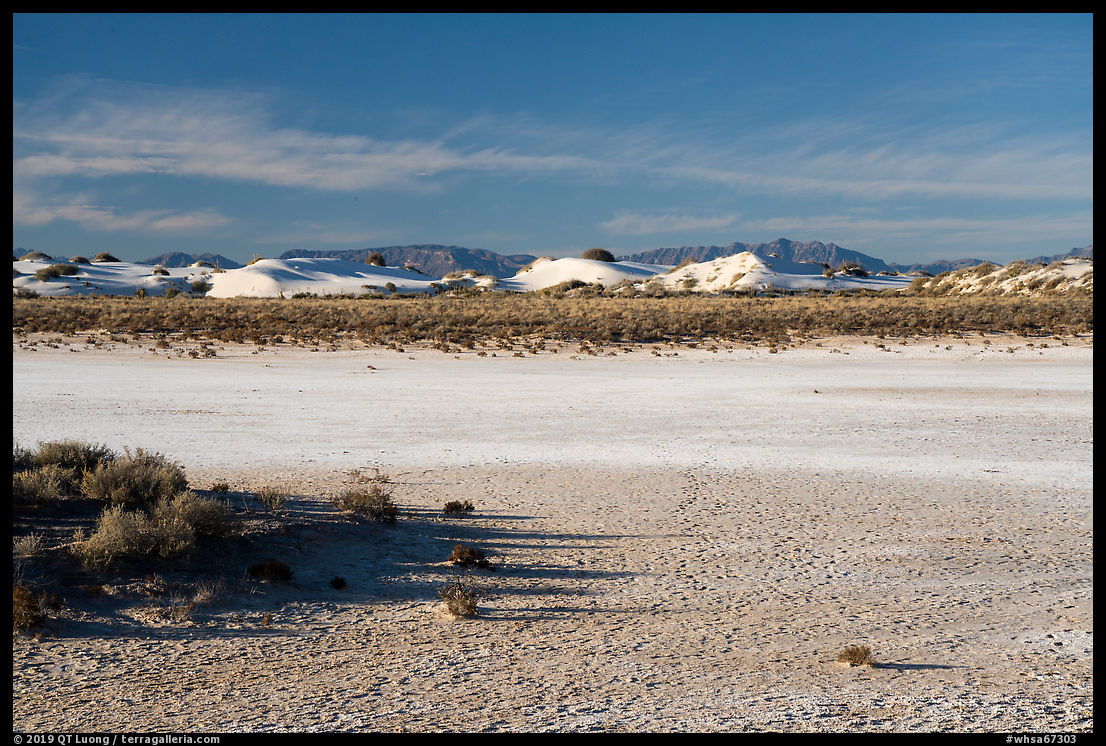
The Playa Trail (0.5-mile round-trip, green markers), doesn’t lead to dunes. Instead, it is the only freely accessible trail in the park from which you can see a playa, which is a shallow depression that fills temporarily with rainwater from storms, mostly during the monsoon season. The ever-changing nature of the playa, which can be white, brown, filled with crystals or water, make it a worthwhile quick stop. If the water is abundant, you may observe wildlife early in the morning there. Stay on this trail to protect the cryptobiotic soil crust. The much larger Lake Lucero playa may be visited on monthly, seasonal ranger-led tours.
Dune Life Trail Area
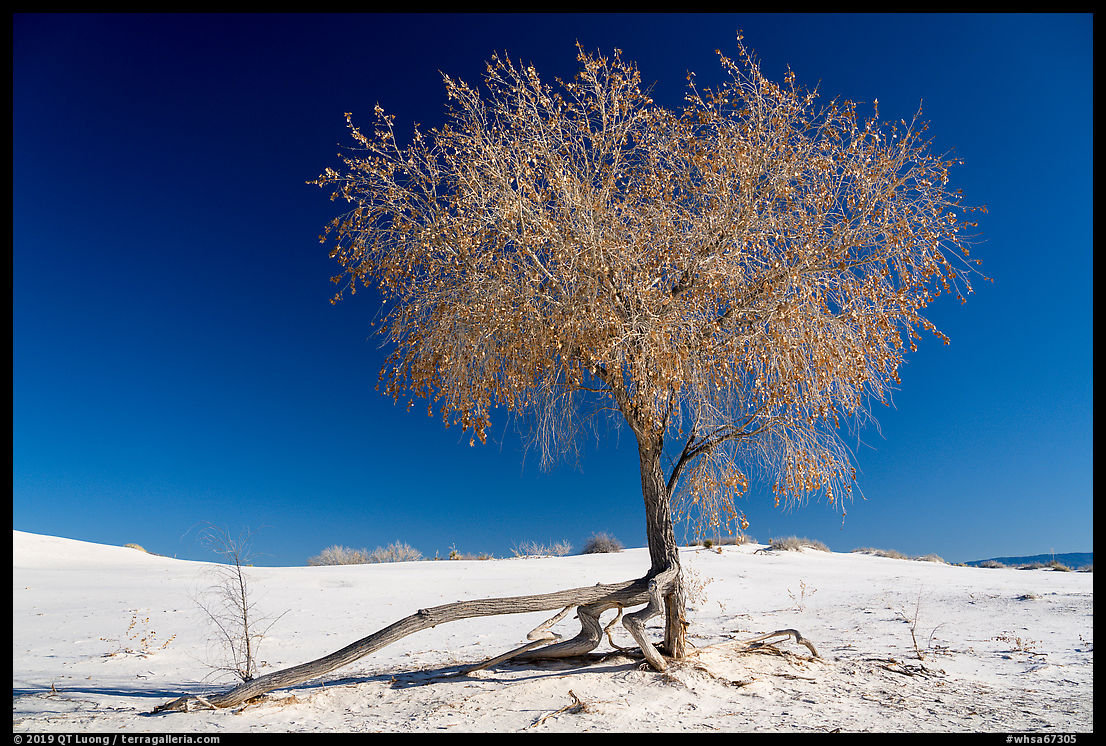
Dunes Drive can be divided into three sections. The first section, from the entrance to Interdune Boardwalk, is characterized by lots of vegetation, but small dunes. The Dune Life Nature Trail (1-mile loop, blue markers) travels along the edge of the dunes where the desert scrub meets the gypsum sand. Although animal life is elusive, I saw plenty of tracks on the sand. On the other hand, plant life is abundant, interesting, and often overlooked. It includes isolated cottonwoods that surprisingly adapted to the sands. More of those trees can be found west of Dunes Drive near the end of the pavement.
Transition Area
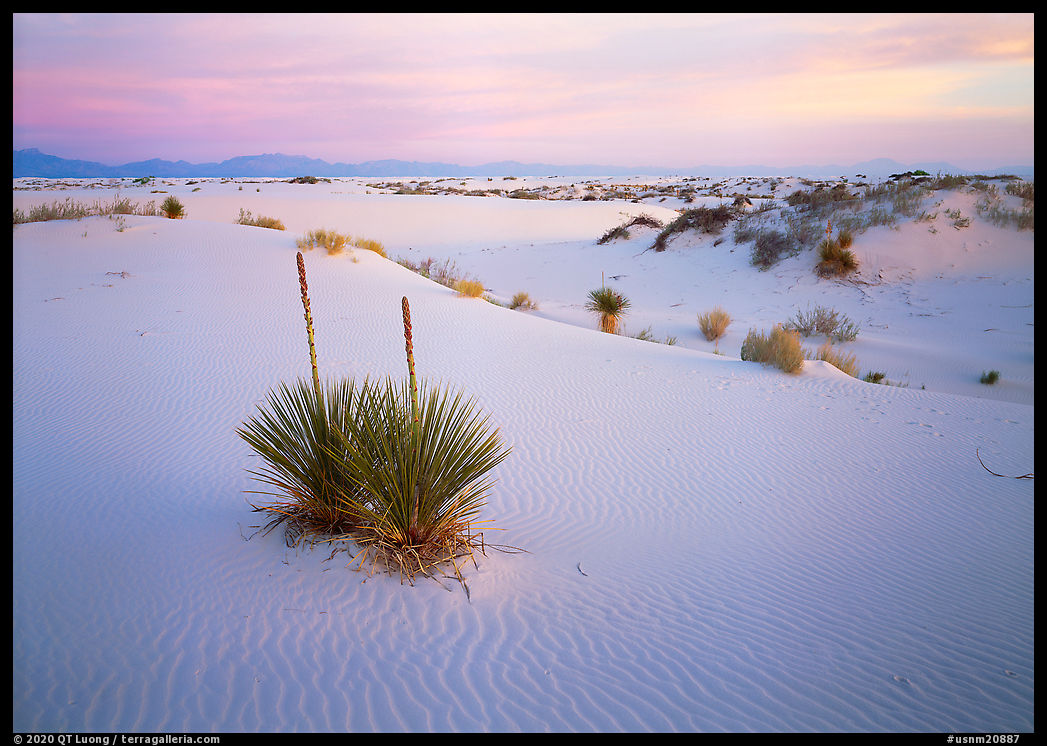
The second section of Dunes Drive, from Interdune Boardwalk to the Backcountry Loop Trail, is characterized by an attractive combination of sizeable dunes and vegetation, most notably soap yucca plants. Of all the plants in the park, the soap yucca is the most iconic because its distinctive shape and color provide a stark contrast with the white sands. In late spring, it displays large cream-colored blooms on stalks, and later in the season, the dried blooms are strikingly dark. Although the dune field appears full of them, finding a nicely isolated and healthy-looking yucca standing in a patch of sand with intact dune ripples required a lengthy search. It is useful to scout the area at midday and use a GPS to mark spots where you’d want to return at sunrise or sunset because due to park regulations, those windows of time are short. By heading straight from the entrance to a pre-scouted spot, I was able to catch a scene at first light. Hiking away from established trails makes it easier to find pristine dunes without footprints. To do so, you could park at the pullout on the west side of the road past the Sunset Stroll meeting area. However, if you are worried about getting lost and prefer to follow a trail marked with poles sticking out of the sand, placed at intervals regular enough that one can go from one pole to the next, you can walk the Backcountry Camping Trail (2.2-mile loop, orange markers).
That trail is typically used by backpackers to access their campsite. The closest one, #9, is barely more than half a mile from the trailhead. Backcountry camping lets you experience a sunset without the need to hurry to get out of the park, and an early set up for sunrise the next morning. The sky above the park is quite dark, so it is excellent for photographing stars. Camping is a strictly regulated affair. Because of the possibility of closure due to missile testing, there are no advance reservations. Competition for the ten sites, which are assigned, can be fierce, with aspiring campers lining up right at park opening time. The park service requires campers to set up their tents before dark and prohibits hiking at night because it would be so easy to get disoriented.
Heart of the Sands
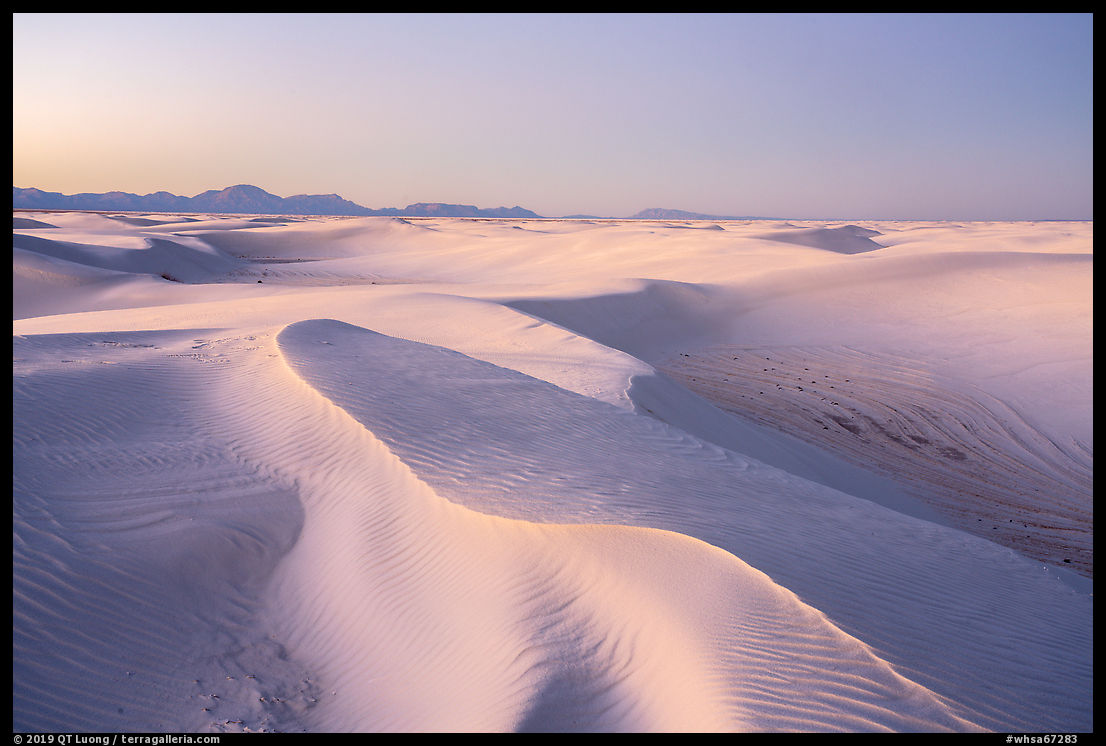
The third section of Dunes Drive, past the Backcountry Loop Trail, is characterized by the largest sand dunes, and almost no soap yucca plants nor other vegetation on the dunes. With no plants to balance the dune compositions, what I look for there are high viewpoints to illustrate the immensity of the dune field. Unlike in Death Valley or Great Sand Dunes, the gypsum dunes are not that high, topping around 60 feet. The tallest dune is about 15 minutes west from the Alkali Flat trailhead.
During the day, you could hike the whole 4.5-mile Alkali Flat Trail loop signed with red markers. Skirting the edge of the largest playa in the area, it goes up and down numerous steep dunes, making it the longest and most difficult trail in the park. However, spots more than 30 minutes from the parking lot are not practical for photographing the sunset and twilight, since you need to give yourself time to get out of the park before it closes. After the sun goes down in White Sands, there is a magical time during which you’ll want to photograph rather than hike, and this means setting up relatively close to your car if you are not camping. The soft light emphasizes the sculptural qualities of the dunes. When photographed backlit, the dunes take a surreal blue color, whereas in other directions, the delicate colors of the sky reflect off the white sands. It is easy to overlook the flats between the dunes, but besides their shrubby vegetation, they are laced with curiously curved ridges that from a distance could be mistaken for tire tracks, but are entirely natural: they are the remnants of migrated dunes.
Poll
Please have a say in the choice of the images for the White Sands National Park section in the next printing of Treasured Lands. The section consists of three spreads. The first spread is settled as follows.
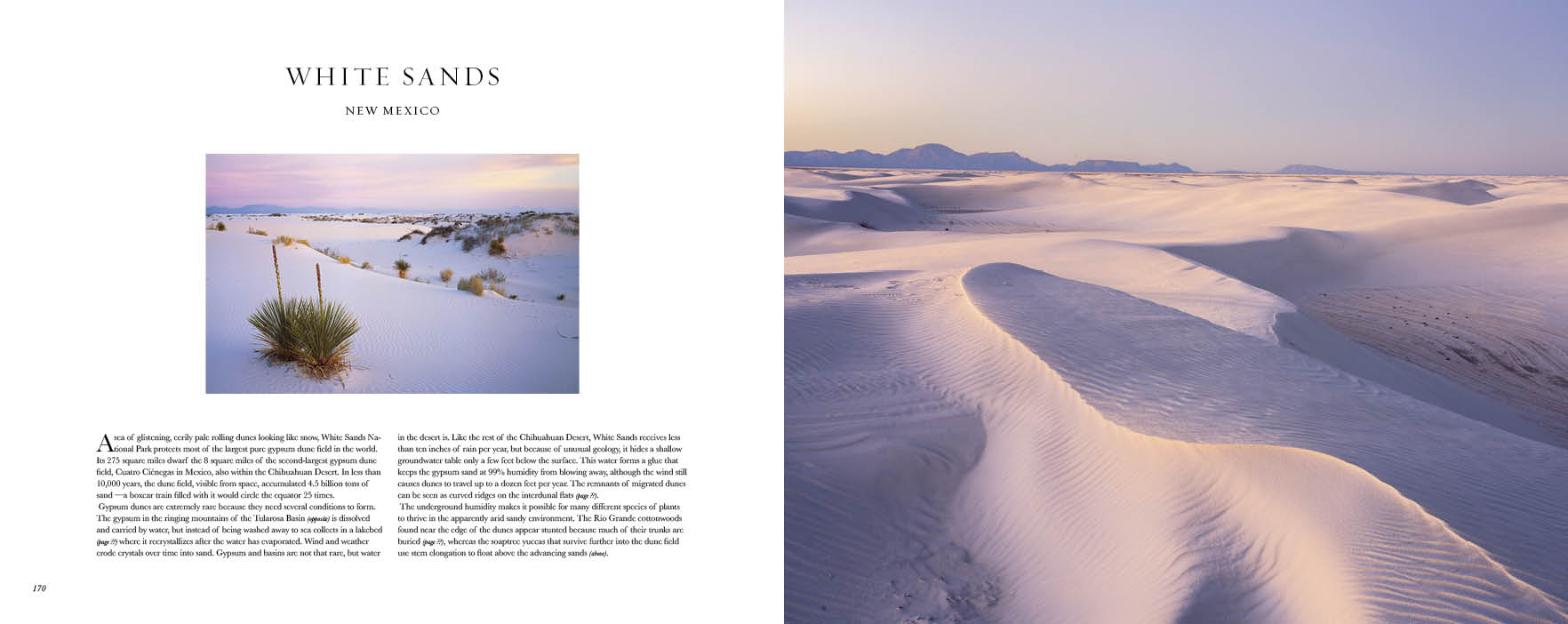
There are four choices for the two last spreads:
1
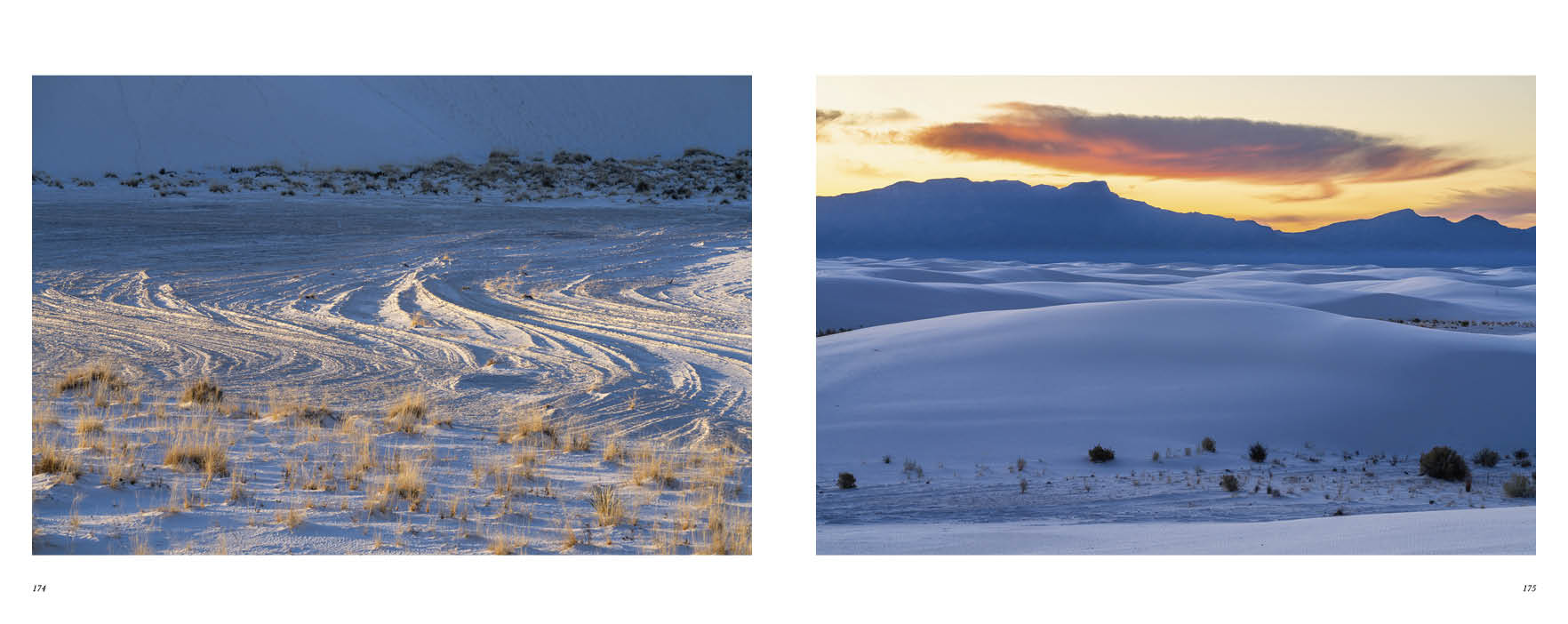
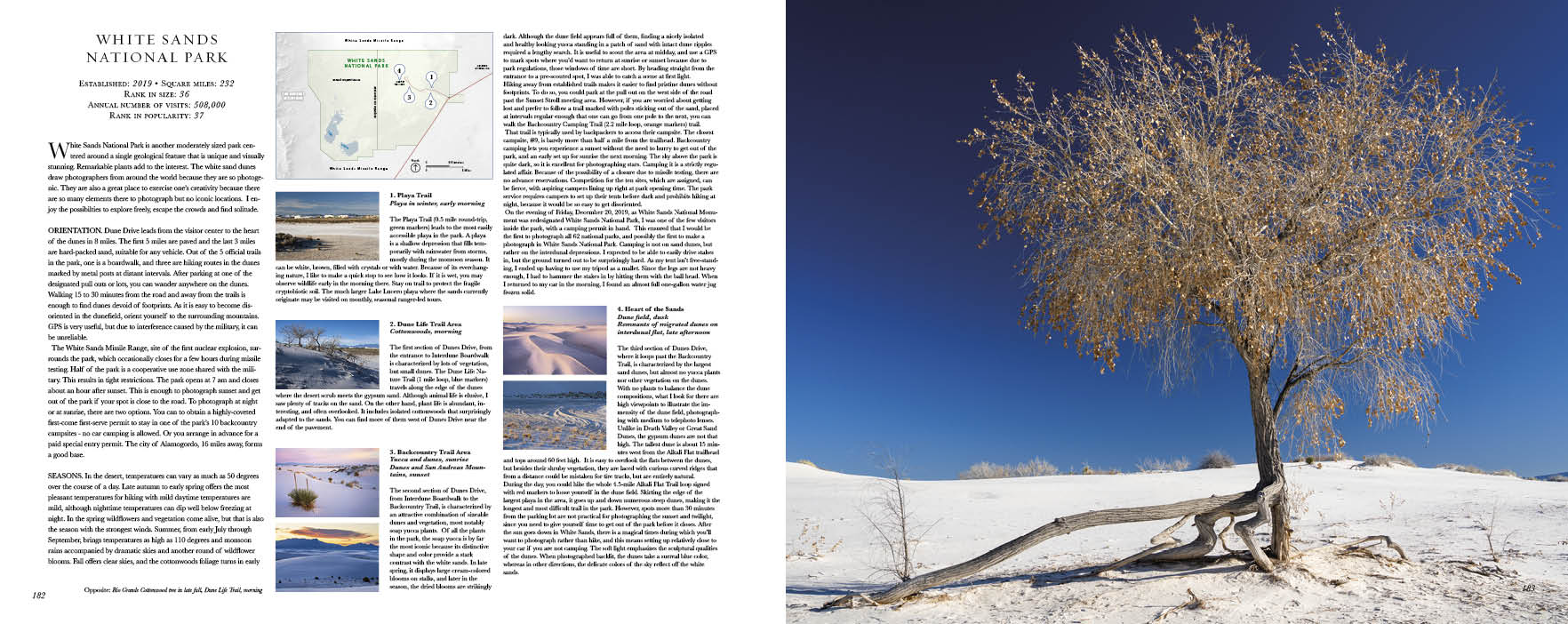
2
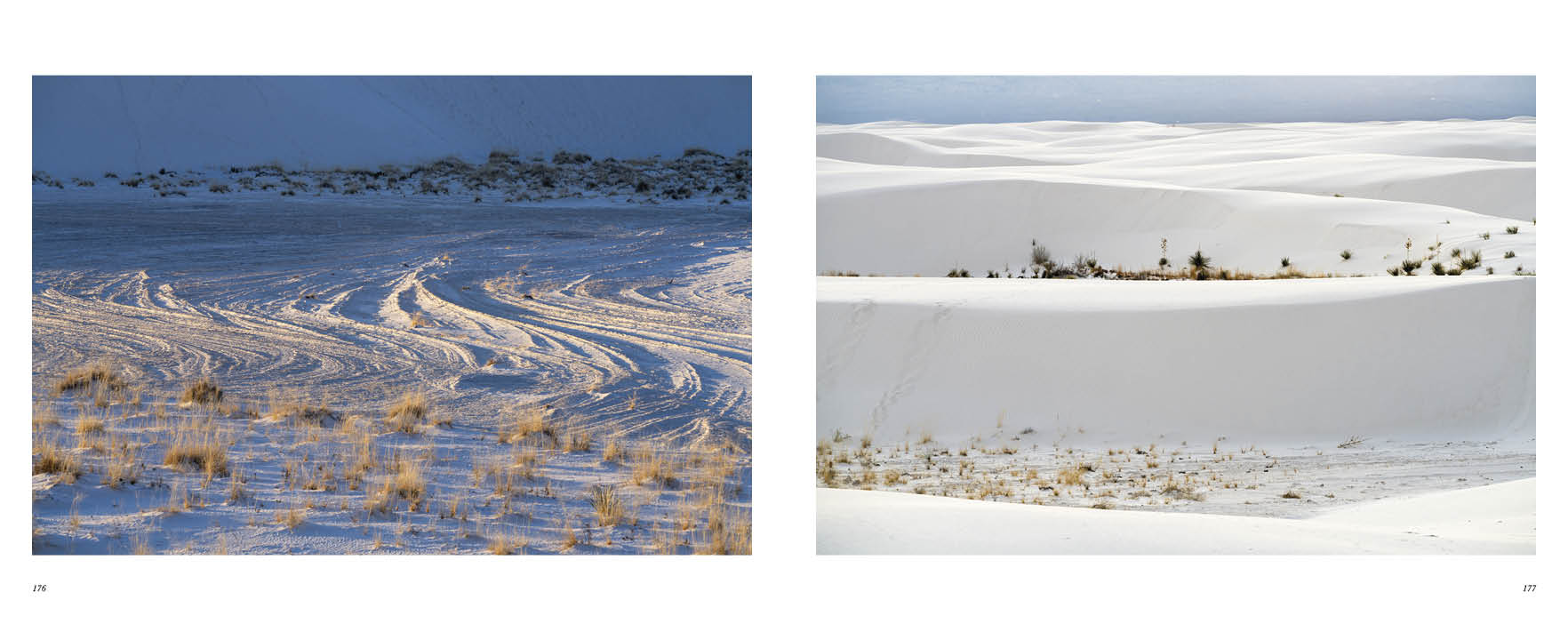

3
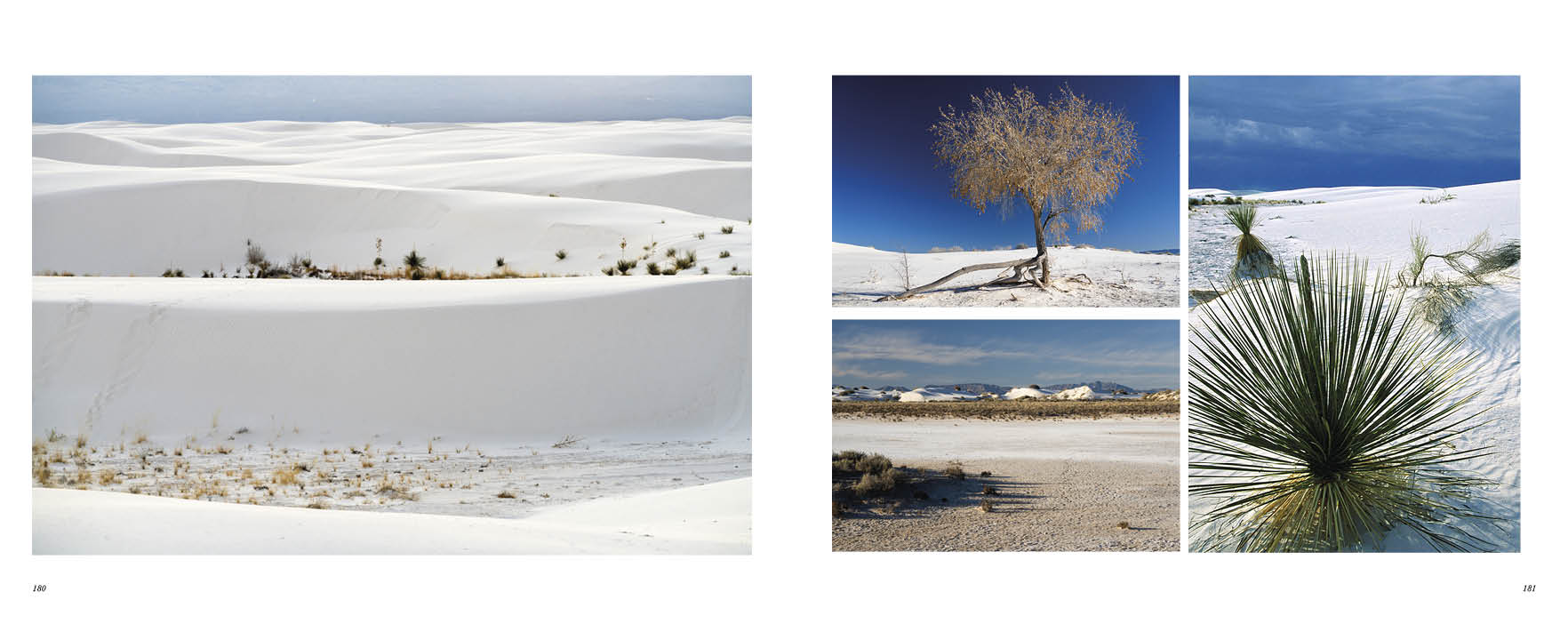
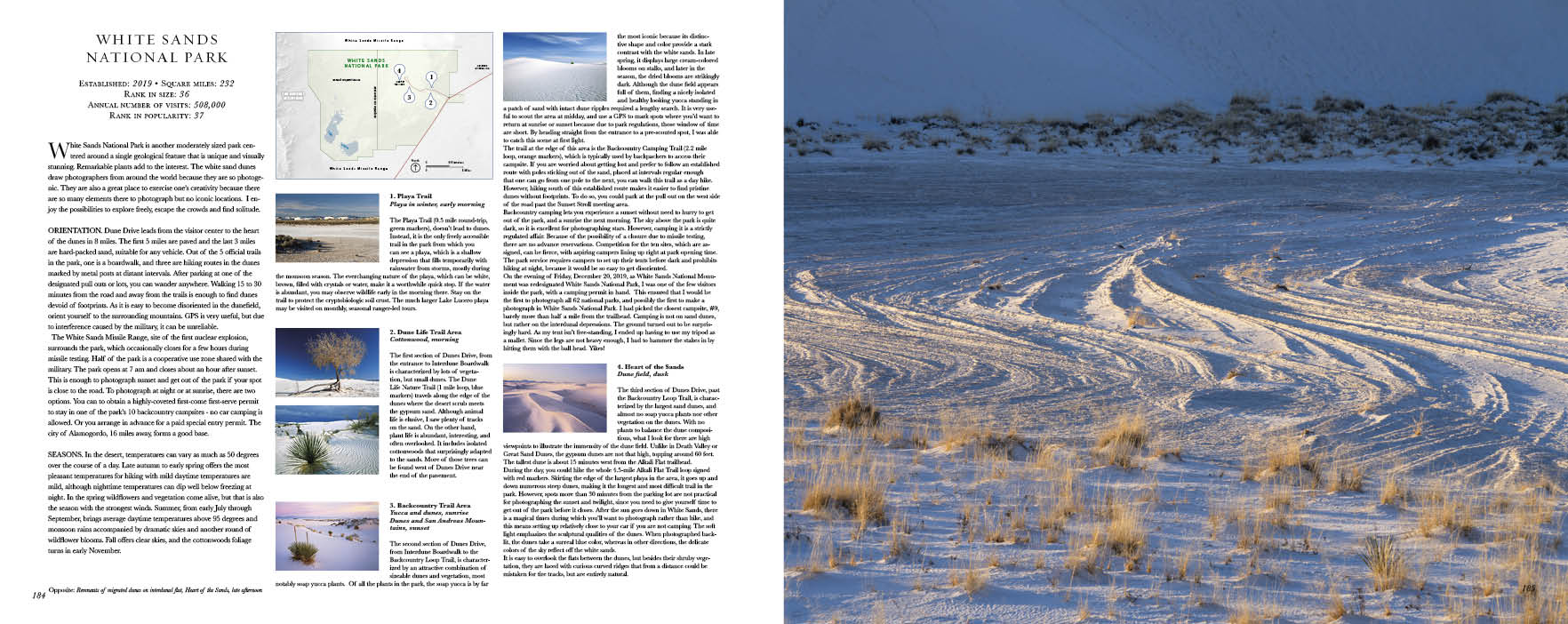
4
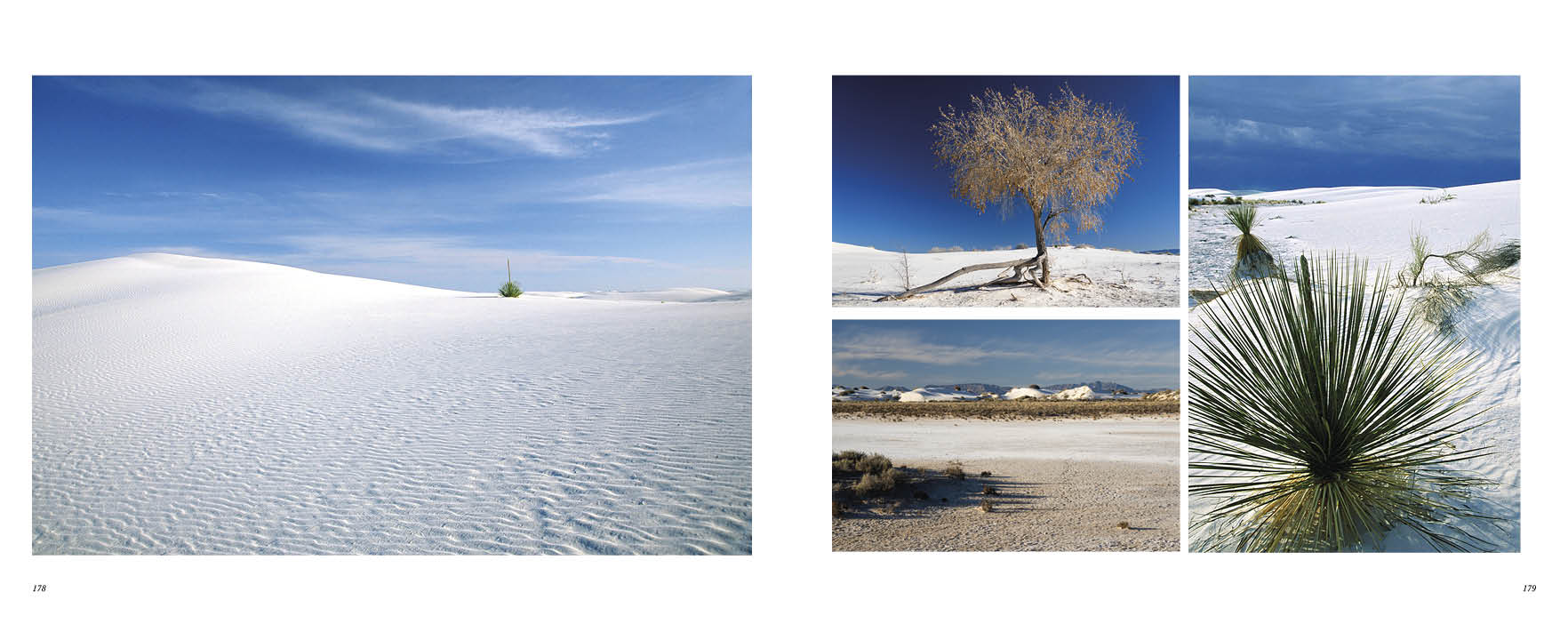

Which spreads do you prefer? If you do not see window below, click here.
Part 1: The First Photographs of White Sands National Park?


the dunes take a surreal blue color”
Do you need an “on” here?
Stunning spread.
Thanks!
Mr. QT,
In the sentence under the Dune Life Trail Area:
“It includes isolated cottonwoods that surprisingly adapted to the sands”
Perhaps consider inserting the word “are” after the word “that” for clarity…it may flow better when reading the passage.
BT
Thanks!
QT, use your own judgement. It is hard to tell at this scale. To me #1 feels more balanced. I can’t really see the value in the white image at the top right of #2. (And I just realized my mistake — I do want to vote for @1, not #2!) And I do like the full-page images rather than trying to show smaller versions of more images. A good image should stand up to relishing, treasuring. Appreciated at many levels — yes, for the overall architecturke (this can be seen in the smaller versions), but also for the details, and for how the whole thing works together at many scales. So I like #1.
The value of that image is to show white sands that actually look white. I feel that some of images are useful to have for editorial reasons, since either they help tell a story about the park or illustrate one of tthe locations, yet they may not work that well full page.
All have a distinctive element of beauty ,I loved them all but The Heart of the Sands has a surreal quality and the Yucca capture in the Transition area the sign of vegetation a stunning contrast of vegetation amidst the the undulating white swathe of carpeting is stunning!
Hi QT. I selected 1, but 4 would be my second choice. To me, 1 is more balanced … and for some reason it bothers me that the leaves in the far right vertical photo in the smaller photo section of 4 are cutoff.
In terms of semantics, please consider inserting a “have” or “are” in the following sentence: “It includes isolated cottonwoods that surprisingly have adapted to the sands.” OR “It includes isolated cottonwoods that are surprisingly adapted to the sands.” And I agree with Mary’s comment above re “the dunes take a surreal blue color”